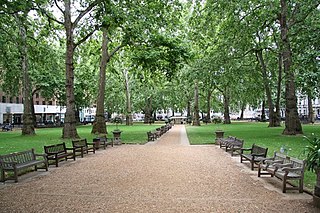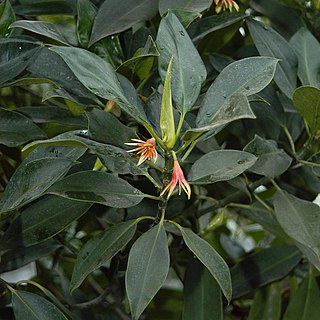
Curtisia dentata is a flowering tree from Southern Africa. It is the sole species in genus Curtisia, which was originally classed as a type of "dogwood" (Cornaceae), but is now placed in its own unique family Curtisiaceae.

Platanus × acerifolia, Platanus × hispanica, or hybrid plane, is a tree in the genus Platanus. It is often known by the synonym London plane, or London planetree. It is a hybrid of Platanus orientalis and Platanus occidentalis.

Alnus glutinosa, the common alder, black alder, European alder, European black alder, or just alder, is a species of tree in the family Betulaceae, native to most of Europe, southwest Asia and northern Africa. It thrives in wet locations where its association with the bacterium Frankia alni enables it to grow in poor quality soils. It is a medium-sized, short-lived tree growing to a height of up to 30 metres (98 feet). It has short-stalked rounded leaves and separate male and female flowers in the form of catkins. The small, rounded fruits are cone-like and the seeds are dispersed by wind and water.

Conocarpus erectus, commonly called buttonwood or button mangrove, is a species of mangrove shrub in the family Combretaceae. It grows on shorelines in tropical and subtropical regions around the world.

Ocotea bullata, is a species of flowering tree native to South Africa. It produces very fine and valuable timber which was formerly much sought after to make furniture. Due to over-exploitation it is now a protected species. Other names for it are Cape Walnut, Cape laurel, and laurel wood. The name "stinkwood" comes from a strong smell that is released when it is fresh felled.

Eucalyptus sideroxylon, commonly known as mugga ironbark, or red ironbark is a small to medium-sized tree that is endemic to eastern Australia. It has dark, deeply furrowed ironbark, lance-shaped adult leaves, flower buds in groups of seven, white, red, pink or creamy yellow flowers and cup-shaped to shortened spherical fruit.

Pandanus utilis, the common screwpine is, despite its name, a monocot and not a pine. It is native to Madagascar and naturalised in Mauritius and the Seychelles.

Agathis orbicula is a coniferous tree native to the island of Borneo. It is found scattered throughout tropical rainforests and Kerangas forests. It is commonly found on hills and plateaus. The species is facing a high risk of extinction due to its scattered distribution and the decline in quality of its habitat.

Olea europaea subsp. cuspidata is a subspecies of the well-known olive tree, which until recently was considered a separate species and is still mentioned as such in many sources. Native to northeast of Africa and the drier parts of subtropical Asia, it has various common names, including wild olive, African olive, brown olive and Indian olive.

Adansonia grandidieri is the biggest and most famous of Madagascar's six species of baobabs. It is sometimes known as Grandidier's baobab or the giant baobab. In French it is called Baobab malgache. The local name is renala or reniala. This tree is endemic to the island of Madagascar, where it is an endangered species threatened by the encroachment of agricultural land. This is the tree found at the Avenue of the Baobabs.

Adansonia suarezensis, the Suarez baobab, is an endangered species of Adansonia endemic to Madagascar. It is locally called "bozy", the common name used for all baobabs in northern Madagascar.

Eucalyptus robusta, commonly known as swamp mahogany or swamp messmate, is a tree native to eastern Australia. Growing in swampy or waterlogged soils, it is up to 30 m (100 ft) high with thick spongy reddish-brown bark and dark green broad leaves, which help form a dense canopy. The white to cream flowers appear in autumn and winter. The leaves are commonly eaten by insects and are a food item for the koala. It is an important autumn-winter flowering species in eastern Australia and has been planted extensively in many countries around the world. Its timber is used for firewood and in general construction.
The wildlife of Mauritius consists of its flora and fauna. Mauritius is located in the Indian Ocean to the east of Madagascar. Due to its isolation, it has a relatively low diversity of wildlife; however, a high proportion of these are endemic species occurring nowhere else in the world. Many of these are now threatened with extinction because of human activities including habitat destruction and the introduction of non-native species. Some have already become extinct, most famously the dodo which disappeared in the 17th century.

Sonchus brassicifolius, synonym Dendroseris litoralis, is a species of flowering plant in the daisy and sunflower family Asteraceae. It is a small evergreen tree species known as the cabbage tree. It is endemic to the Juan Fernández Islands, which lie in the southeast Pacific, off the west coast of Chile. It is native only to the tiny, volcanic Robinson Crusoe Island, home of the famed Juania australis and many other endemic plants. The species is threatened by habitat loss and has been brought back from the brink of extinction. It had been reduced to only a few individuals by feral goats on the island, and is still considered critically endangered.

Hyophorbe vaughanii is a species of flowering plant in the family Arecaceae that is endemic to Mauritius. Its natural habitat is subtropical or tropical dry forests.

Bruguiera gymnorhiza, the large-leafed orange mangrove or oriental mangrove,) is a mangrove tree that grows usually to 7–20 metres (23–66 ft) high, but sometimes up to 35m, that belongs to the family Rhizophoraceae. It is found on the seaward side of mangrove swamps, often in the company of Rhizophora. It grows from the Western Pacific across Indian Ocean coasts to Cape Province, South Africa.

Pararchidendron pruinosum is an Australian rainforest tree growing from the Shoalhaven River in New South Wales to Herberton in north Queensland. It is also native to New Guinea and to Java, Sulawesi, and the Lesser Sunda Islands in Indonesia. Common names include Snow-wood, Tulip Siris and Monkey's Earrings. It is the sole species in genus Pararchidendron.

Labourdonnaisia calophylloides is a species of plant in the family Sapotaceae native to the islands of Mauritius and Réunion in the Indian Ocean.

Labourdonnaisia is a genus of plants in the family Sapotaceae found in tropical Asia, described as a genus in 1841.

Diospyros revaughanii is a rare species of tree in the family Ebenaceae (ebony).




















